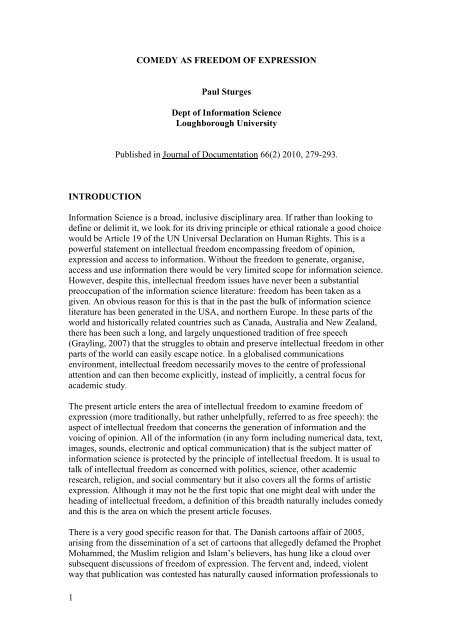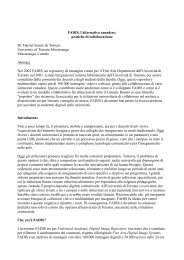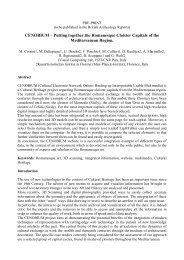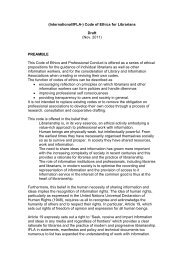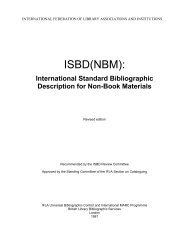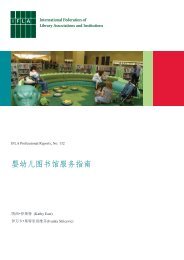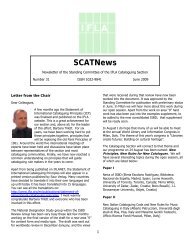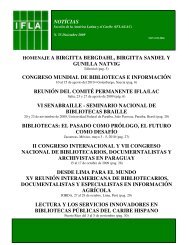COMEDY AS FREEDOM OF EXPRESSION - IFLA
COMEDY AS FREEDOM OF EXPRESSION - IFLA
COMEDY AS FREEDOM OF EXPRESSION - IFLA
You also want an ePaper? Increase the reach of your titles
YUMPU automatically turns print PDFs into web optimized ePapers that Google loves.
<strong>COMEDY</strong> <strong>AS</strong> <strong>FREEDOM</strong> <strong>OF</strong> <strong>EXPRESSION</strong><br />
Paul Sturges<br />
Dept of Information Science<br />
Loughborough University<br />
Published in Journal of Documentation 66(2) 2010, 279-293.<br />
INTRODUCTION<br />
Information Science is a broad, inclusive disciplinary area. If rather than looking to<br />
define or delimit it, we look for its driving principle or ethical rationale a good choice<br />
would be Article 19 of the UN Universal Declaration on Human Rights. This is a<br />
powerful statement on intellectual freedom encompassing freedom of opinion,<br />
expression and access to information. Without the freedom to generate, organise,<br />
access and use information there would be very limited scope for information science.<br />
However, despite this, intellectual freedom issues have never been a substantial<br />
preoccupation of the information science literature: freedom has been taken as a<br />
given. An obvious reason for this is that in the past the bulk of information science<br />
literature has been generated in the USA, and northern Europe. In these parts of the<br />
world and historically related countries such as Canada, Australia and New Zealand,<br />
there has been such a long, and largely unquestioned tradition of free speech<br />
(Grayling, 2007) that the struggles to obtain and preserve intellectual freedom in other<br />
parts of the world can easily escape notice. In a globalised communications<br />
environment, intellectual freedom necessarily moves to the centre of professional<br />
attention and can then become explicitly, instead of implicitly, a central focus for<br />
academic study.<br />
The present article enters the area of intellectual freedom to examine freedom of<br />
expression (more traditionally, but rather unhelpfully, referred to as free speech): the<br />
aspect of intellectual freedom that concerns the generation of information and the<br />
voicing of opinion. All of the information (in any form including numerical data, text,<br />
images, sounds, electronic and optical communication) that is the subject matter of<br />
information science is protected by the principle of intellectual freedom. It is usual to<br />
talk of intellectual freedom as concerned with politics, science, other academic<br />
research, religion, and social commentary but it also covers all the forms of artistic<br />
expression. Although it may not be the first topic that one might deal with under the<br />
heading of intellectual freedom, a definition of this breadth naturally includes comedy<br />
and this is the area on which the present article focuses.<br />
There is a very good specific reason for that. The Danish cartoons affair of 2005,<br />
arising from the dissemination of a set of cartoons that allegedly defamed the Prophet<br />
Mohammed, the Muslim religion and Islam’s believers, has hung like a cloud over<br />
subsequent discussions of freedom of expression. The fervent and, indeed, violent<br />
way that publication was contested has naturally caused information professionals to<br />
1
question how far it was legitimate, and safe, to make content available when it caused<br />
such measurable harm. A review of the issues (Sturges, 2006) adopted the language of<br />
human rights and drew on a series of Articles from the UN Declaration including<br />
Article 19. It also took the opportunity visit the literature of comedy (cartoons being a<br />
comic form that combines graphics and text to tell stories and make points) so as to<br />
introduce approaches used in comedy to soften or moderate the force of satire. In<br />
particular, it introduced the concept of decorum, which ‘can be defined as a decision<br />
about the form of expression which is publicly judged appropriate for a given setting<br />
and theme’. (Palmer, 2005, p.80) However, there need to be clear ideas on how and<br />
why this is done if expression is to be assessed as to whether it is appropriate for a<br />
given setting or theme. If that is not the case, there is increased potential for indirect<br />
means of suppressing urgent and necessary comment. These types of indirect<br />
suppression, including self-censorship, are sometimes referred to as soft censorship.<br />
What is offered in the present article is an account of how comedians (stand up<br />
comedians mainly) assess their own material and performance. The idea is that if we<br />
look at an area of expression that is frequently on the cutting edge of risk, we can<br />
begin to form ideas of how far expression generally is subject to similar processes and<br />
encounters forms of indirect censorship. Comedy is sometimes treated as if were<br />
inconsequential, a means of amusement, merely merriment. The contention here is<br />
that the preponderant bulk of comic expression, possibly everything except the most<br />
whimsical and light hearted, is actually a highly necessary commentary on life.<br />
Comedy begins with personal reflections on the oddities and anomalies of life in<br />
which any individual indulges, but it takes on a broader, and even universal,<br />
significance when a writer, performer or visual artist structures that reflection into a<br />
comic form. Dismissing comedy as just a laughing matter misses this point. Comedy<br />
will be treated seriously, but not solemnly, in this article: its status as free expression<br />
deserves that much respect. The question that this article will address is ‘How can we<br />
identify reasonable limits, if any, to freedom of expression through an analysis of the<br />
perceptions of comedians?’ The implicit purpose is to examine the extent to which<br />
this enables those, such as information professionals, who work with the products of<br />
freedom of expression to clarify their perceptions of restrictions on acquisition and<br />
access to controversial materials.<br />
DEFINITIONS AND CONTEXT<br />
So far we have been proceeding more or less on the assumption that everyone knows<br />
what comedy is. This section will, in the process of defining and contextualising<br />
comedy, introduce the themes that will be present in the following sections.<br />
Definitions are very much necessary with something as ubiquitous and embedded in<br />
the culture as comedy. One way of approaching at it is first of all to identify a broad<br />
domain of humour. This is the area of the funny or amusing in life, whether accidental<br />
or deliberately contrived, whereby a smile or laugh might be provoked. Thus, on the<br />
one hand, kittens playing in their entirely uncontrived way may be humorous, whilst<br />
on the other, so is an elaborate mime by Marcel Marceau (allegedly). Comedy can<br />
then be seen as the sub domain of the humorous in which humour is turned into art by<br />
mime artists, dramatists, television writers, cartoonists, music hall singers, stand up<br />
comedians and many others, including millions of ‘funny people’ who bring comedy<br />
into everyday life. Not all writers on the topic make this distinction and it is quite<br />
2
common to find the term humour used in the way that comedy is here – to mean the<br />
contrived aspects of humour.<br />
Thus Oring (2003, p.145) uses the term humour in this more limited way in a valuable<br />
passage on the contexts of humour. He says that:<br />
These contexts include the experiences that an individual brings to the humour<br />
that he or she hears and performs; the social interaction in which the humorous<br />
performances are embedded; the social and historical conditions in which<br />
jokes arise, proliferate and disappear; the cultural knowledge upon which<br />
humour depends and with which it plays; and the range of experience, both<br />
within and beyond a society’s boundaries with which localised humorous<br />
performance may be compared or contrasted.<br />
What Oring is doing here is to show that an instance of comedy, or humour as he calls<br />
it, is not a universal phenomenon. It occurs in a specific cultural context and may very<br />
well not be seen as comedy at all in a different context. We can safely accept Oring’s<br />
point as meaning, at least to some extent, that there are different senses of humour in<br />
different cultures. What is more there is a suspicion, which only cultural<br />
anthropologists could fully confirm, that the density of comedy varies from place to<br />
place. To illustrate the point, if one listens to a cheerful exchange between a group of<br />
African friends, there will certainly be much laughter and many cheerful remarks, but<br />
very few actual jokes. The introduction of a good joke into an African conversation<br />
will certainly receive an ecstatic welcome.<br />
This brings us to the joke; the vehicle through which comedy is communicated. A<br />
working comedian’s thoughts on the subject can be found in Carr and Greeves (2006).<br />
This is very definitely not a scholarly work, but it makes its points with hundreds of<br />
good jokes. Holt (2008)’s elegant essay on jokes also illustrates the form very<br />
effectively. Freud (2002) is still probably the most quoted authority on the joke. He<br />
called the joke a combination of [comic] technique and [humorous] thought. Though<br />
this sounds banal, it works. The thought is a perception of something arguably<br />
humorous (the sort of verbal coincidence that makes a pun, someone who walks in a<br />
strange way, a relationship that functions badly, or even a gross political or social<br />
injustice). The technique is the presentation of this perception in a way that points up<br />
its comic quality. The technique may be physical (a pose or a rolled eye), is most<br />
commonly verbal, but can be graphic or musical; there is no real restriction. The joke<br />
is usually regarded as a discrete comic structure that can stand independently, but it<br />
can be embedded in an extended comic performance the related elements of which<br />
can sometimes be referred to together as a joke. A joke is most effective when<br />
delivered with the judgement and timing of a practiced comedian and when emerging<br />
convincingly from a natural or well realised comic persona. Jokes are usually<br />
regarded as existing in a realm not wholly governed by the everyday requirements of<br />
tact and consideration for others but Freud himself, as Willis (2005) points out,<br />
distinguished between innocent and contentious jokes. Phrases such as ‘Just joking’<br />
or ‘Only a joke’ are often introduced in conversation when there is a perception that<br />
offence may have been caused and there is a need for distance from a particularly<br />
contentious joke.<br />
The potential offensiveness of a joke or comedy more generally, is considerable and<br />
this is the focus of our attention here. The reason for this lies in the content of perhaps<br />
the most central strand of comedy, which is the carnivalesque celebration of<br />
3
disrespect and contempt for the usual restraints and icons of polite life. True, there is<br />
purely playful comedy: puns and other wordplay, gentle whimsy and the less<br />
aggressive manifestations of physical comedy, or slapstick. But Jacobson (1997,<br />
p.137) draws our attention to the dangerous side of comedy and suggests a role for it:<br />
In hostility and aggression is our beginning. Comedy cannot hope to change<br />
that. But by making a play of our incorrigible combativeness, it propitiates it,<br />
harmonizes us with it. And more than that, reminds us of our inexhaustible<br />
capacity to evade the burden of sympathy and the compulsion to suffer.<br />
Bakhtin (1968)’s analysis of carnival identifies a space granted by civil and religious<br />
authority in the medieval and early modern period in which this aggression was<br />
temporarily given license. At carnival time people feasted and drank and participated<br />
in comic celebration in which ‘the body copulates, defecates, overeats, and men’s<br />
speech is flooded with genitals, bellies, defecations, urine, disease, noses, mouths and<br />
dismembered parts’ (p.319). This is still the central core of uninhibited comedy and it<br />
is, in itself, offensive to those who hold authority and to members of polite society<br />
who deny their own earthy origins and needs as much as they are able.<br />
As Henkle (1980, p.13) puts it: ‘Comic works characteristically expose pomposity<br />
and smug self-deception, and undermine dull and inhuman mores. By toppling those<br />
authorities comedy encourages us to understand what is masked by rigorous, sombre<br />
approaches to human behaviour.’ The problem is the virtual certainty that<br />
unrestrained comedy will give specific offence and produce outraged reaction from<br />
individuals and groups sooner or later. Some comedians will claim that there is both a<br />
right and a necessity to offend. Rowan Atkinson in commenting on the schedule in the<br />
UK Serious Organised Crime and Police Bill of 2004 that sought to outlaw speech,<br />
publication or performance that would incite religious or racial hatred, claimed that<br />
‘the right to offend is far more important than any right not to be offended’. (Left and<br />
Happold, 2004) Roy ‘Chubby’ Brown, a performer whose material is seldom if ever<br />
broadcast, but whose live performances are a tumultuous rally of powerful feelings<br />
that can not usually be given voice, sings a song (not a very good song, but a<br />
significant one) called The Right to Offend. Andy Medhurst says of him that his<br />
importance is that ‘He gives a voice to people who don’t have one. He sticks up two<br />
fingers at the liberal-progressive consensus, and stands up for the white,<br />
predominantly northern working class.’ (Arnot, 2007) The Italian comedian Sabina<br />
Guzzanti, threatened with prosecution in 2008 for insulting the Pope, argued that ‘I<br />
believe that in a democracy there is no right not to be offended. I think that anyone<br />
ought to be free to say whatever he or she likes at any moment.’ (Hooper, 2008).<br />
In contrast, there are many, members of religious denominations in particular, who<br />
believe quite the opposite. Christians protested in enormous numbers, some of them<br />
very threateningly, against TV transmissions of Jerry Springer: the Opera (with its<br />
disrespectful comic presentation of Christ) and Sikhs in Birmingham halted the run of<br />
the play Behzti because it included scenes of crime in a gurdwara. Muslims have<br />
demonstrated against Salman Rushdie’s The Satanic Verses as well as the Danish<br />
cartoons. In September 2008 there was similar controversy over Sherry Jones’s novel<br />
The Jewel of Medina, on the life of Mohammed’s last wife Aisha before it was even<br />
published. (Khaleeli, 2008) There is a divide here between the believers in free<br />
expression at all costs and the religious (or political) believers who put faith and<br />
social stability before full freedom of speech. This article offers commentary on this<br />
thoroughly uncomfortable fault line at the edge of free expression. As Lockyer and<br />
4
Pickering (2005, p.5) put the question, ‘So how do we negotiate the perilous terrain<br />
that lies between humour and offensiveness, or free speech and cultural respect, in a<br />
pluralist society?’<br />
METHODOLOGY<br />
The present study is based on four sources: the literature of comedy, current reportage<br />
of specific controversies, observation of comedians in performance, and interviews<br />
with comedians. The literature of comedy is vast and growing. Medhurst (2007) is a<br />
recent work that builds on a good selection from this wealth of choice. Works by<br />
Legman (1968), Moreall (1983), Palmer (1994) and Billig (2005) are worth<br />
mentioning as providing particularly relevant context. As comedy is a national<br />
preoccupation in Britain, coverage of comedians and their clashes with those who<br />
would restrict them are common in the press and significant stories occurring while<br />
this study was in progress have been taken into account. For instance, a performance<br />
by Johnny Vegas in 2008 led to a public controversy on what was comedy and what<br />
was sexual abuse of an audience member. (O’Hara, 2008) Any attempt at<br />
comprehensive observation of comedy in performance in Britain would require a<br />
major study. The number of comedians appearing at regular comedy clubs and giving<br />
solo performances in major public halls is too great for a small exploratory exercise<br />
such as the present one. The quantity of comedy transmitted on television or available<br />
via the Internet is also enormous, but has been largely ignored here because of the role<br />
of editors and producers in making it less of an individual art form.<br />
During the first half of 2008, for the purposes of this study, a selection of comedians<br />
was observed at several venues in the English Midlands but mainly at the Derby<br />
Funhouse Comedy Club (or, in other words, the author attended comedy gigs in his<br />
home town). Thanks to the kind cooperation of promoter/compere Spiky Mike,<br />
interviews and short conversations were obtained with a number of comedians (12 in<br />
total, plus an interview with Spiky Mike himself). In order not to overload the text<br />
with notes, the various performances observed and the interviews are listed in the<br />
Appendix. The reader can use this to check whether it is a performance or interview<br />
that is used as the source of an opinion attributed to a comedian. The interviews were<br />
informal, allowing the interviewees to express their own thoughts on two questions:<br />
what restrictions they perceived to their comedy, and what they identified as the<br />
sources of these restrictions. The interviewees included both male and female<br />
comedians, experienced performers and beginners, comedians with national profiles<br />
and others with mainly regional exposure. Particular help was provided by one<br />
comedian, Dave Longley who followed up a long and interesting interview with an<br />
equally long and interesting email.<br />
The comedians were fluent and willing talkers. Interview notes were taken and<br />
written up within 24 hours in each case, but this means that there are no verbatim<br />
quotes in this article: it is reported speech only. Furthermore, the results of this<br />
interview programme are not presented as a definitive statement on comedians and<br />
freedom of expression. The interviews offer an insight into what some comedians say<br />
about their material and performances, which does no more than offer scope for a<br />
sketch of their motivation and the outcomes of their personal interface with<br />
controversy. This content of this sketch has a certain consistency, which suggests that<br />
5
a major, structured survey might not reveal anything strikingly different. What this<br />
type of study does definitely do, of course, is to offer plenty of clues as to lines for<br />
further investigation should anyone require them.<br />
The comedians interviewed for this study often tended initially to find it a little<br />
difficult to see their work in terms of restrictions. There is a body of law in the UK<br />
that could be used to investigate and prosecute on charges such as obscenity,<br />
blasphemy and defamation. In practice this body of law has seldom been used since<br />
the 1960s when there were a few high profile cases concerning publications (Lady<br />
Chatterley’s Lover, Oz, etc) and when film and theatre censorship was generally<br />
discredited through the manifest social irrelevance of the interventions of the Lord<br />
Chamberlain’s Office, the British Board of Film Censors (now Classification) and<br />
local licensing committees. Performances on premises licensed for entertainment are<br />
today unlikely to attract any official or police attention. Performers delight in pressing<br />
at the boundaries; swearwords are used for punctuation and emphasis; and sex,<br />
previously one of the greatest taboos, is celebrated and profaned by them all. An<br />
American movie The Aristocrats (Jillette and Provenza, 2005) gives a flavour of this<br />
as comedians compete to make a single joke more obscene with every telling.<br />
Material not so different from this can be heard in British comedy clubs every night of<br />
the week. A survey of what might be called the problem topics (effectively the whole<br />
content of stand up comedy) will be followed by an account of the restraining<br />
impulses that do effectively define limits to comedians’ freedom of expression.<br />
THE ARE<strong>AS</strong> <strong>OF</strong> CONTROVERSY<br />
It is clear from the interviews that comedians do make clear and conscious selections<br />
of material and choices of modes of expression. What is described in this section is a<br />
description of what one might have heard in small comedy venues with a<br />
predominantly young audience, in the English Midlands in the year 2008. The reader<br />
must judge whether it seems typical of what might be experienced in other venues at<br />
other times. The important thing is not whether it is entirely typical (it may not be),<br />
but that it definitely shows comedians choosing their material on the basis of some<br />
kind of reflection on what they want to say, and the possible limits that might apply to<br />
that. Their reflection, as represented in this study, resulted in material with a pattern<br />
that can be outlined as follows.<br />
First of all, politics, in the sense of commentary on parties, government and policy<br />
was almost entirely absent. This undoubtedly represents a cynical sense that politics is<br />
beyond a joke. It is in sharp contrast to the perception that comedians should have a<br />
political message, which was prevalent in the ‘alternative’ comedy of the Thatcher<br />
years (broadly the 1980s). In 2008 the comedy club material observed in this study<br />
more or less entirely lacked the kind of engagement that produces political satire.<br />
Comedians seldom felt it worthwhile even to introduce personal abuse towards<br />
politicians. Social comment with political implications was also not particularly<br />
apparent. Commentators actually detect a tendency towards abuse of the<br />
underprivileged and disaffected, often referred to as ‘chavs’. (Williams, 2008) Issues<br />
with political resonance, such as homelessness and domestic abuse were largely<br />
ignored, and Gareth Richards and Reeves Peterson agreed that this was usually too<br />
risky an area for comedy. Global warming and environmental issues were also more<br />
6
or less absent and Russell (2008) quotes the comedian Marcus Brigstock to the effect<br />
that audiences can positively reject this type of material.<br />
Religion was a frequent topic possibly, it seemed, because the idea of a god and body<br />
of faith was considered inherently comic. There was also a powerful sense that<br />
religion was not a force for good, and that its leaders, priests, practices and beliefs<br />
ought to be subject to deserved ridicule. The most obvious target was the Catholic<br />
Church, but despite the comparatively large number of its adherents in relation to<br />
other denominations and religions in an otherwise unbelieving Britain, it does not<br />
actually seem a subject of urgent interest to comedy club audiences. Thus Dave<br />
Longley’s tirades against Mother Teresa and the Pope appeared to be merely amusing<br />
to the audience. Richard Herring’s gentle satire on Christ’s Ascension, discussing it in<br />
terms of space travel, at the same gig produced a similar response. Jim Jeffries’<br />
scathing assault on Christian belief, including Creationism (‘magic’, in his words)<br />
was also happily received. This is in contrast to the move, later abandoned in the face<br />
of international ridicule, to prosecute Sabina Guzzanti for ‘contempt of the Pope’<br />
under a superseded treaty between the Vatican and the Italian state. (Hooper, 2008)<br />
In contrast, the human body was both celebrated and deplored. Jokes that target<br />
people for distinctive features of their appearance, for instance, red haired people<br />
(gingers), are in wide circulation and appeared in the performances observed. Taunts<br />
at ugly people were common, despite the risk that audience members might have<br />
found them deeply wounding. Drunkenness was both celebrated and used as a route to<br />
comedy of discomfort. Gluttony was another classic element of carnival-type comedy<br />
that was a rather less frequent subject. Its consequences were, however, present in<br />
many comedians’ material. A comedian such as Jethro has built a highly successful<br />
career on an incontinent stream of scatological material. Jibes at fat people are<br />
frequent. Both Chubby Brown’s name, and the ecstatic chant with which his admirers<br />
greet him (You fat bastard! You fat bastard!) indicate that his mockery of the obese is<br />
based on complicity between his fat self and theirs. Yet, the jokes are cruel and the<br />
real responses underlying the laughter of the many overweight people in his audiences<br />
would be interesting.<br />
Disablement was also a target that many of the comedians were unable able to resist.<br />
A disabled performer such as Gareth Berliner explored the comic implications from<br />
the inside, but most other comedians regard it as beyond their limits. Spiky Mike told<br />
of a comedian with cerebral palsy who caused an audience member with the same<br />
condition to walk out. Despite their shared difficulties she was not amused by his<br />
material. Danny McLaughlin found that some material on a one-armed person was<br />
softened by making the character his grandfather. Disease, particularly cancer, which<br />
almost everyone seems to encounter directly or indirectly, is regarded as a risky area,<br />
but Mel Moon pointed out that cancer-sufferers themselves often use black humour<br />
about their condition. The comedians found this a difficult line to tread, but<br />
interestingly AIDS was regarded as sufficiently far from most audience members’<br />
experience to make it an occasional subject of jokes.<br />
In contrast, the healthy body was celebrated by all the comedians and sex dominated<br />
their content. The comedy club audience is young and they clearly welcome very<br />
explicit comedy on the whole spectrum of what people do for sexual gratification.<br />
When pressed, young female audience members admitted to owning and using<br />
7
vibrators. The comedians talked freely about masturbation, usually making no secret<br />
that it was their own experience that they were describing. Homosexuality was not<br />
handled very sympathetically and audiences seemed to accept derogatory references<br />
to gay people. This was not always the case, however, and Zoe Lyons’ magnificently<br />
comic routine comparing homophobia to arachnophobia was a superb example of<br />
delicate handling of the topic. (Darling, there’s a homosexual in the bath, please could<br />
you get rid of it for me).<br />
The aspect of sex that was considered most problematic was rape. Some comedians<br />
admitted that they quite consciously steered completely clear of it, and Danny<br />
McLaughlin had decided not to use a rape joke that was otherwise ‘good’ in terms of<br />
its structure and effectiveness. Sarah Millican, recounted an occasion when a woman<br />
who had just suffered an incidence of sexual violence and had been brought out ‘to<br />
cheer her up’, was distressed by some material with a rape theme. Millican was not<br />
happy about this, but felt confident that if the woman had been able to listen more<br />
closely, she would have realised that what was said came from a solidly feminist<br />
perspective. At the same time Jim Jeffries appeared to celebrate rape in parts of his<br />
material. It is true that his material could be read as commentary on the blanket<br />
distrust of men, and a related view of women as automatically candidates for victim<br />
status, that is current in some circles. The overwhelming male audience on this<br />
occasion might not have perceived this subtext.<br />
Interestingly, paedophilia was an area of sexuality which occurred frequently in the<br />
material observed. Spiky Mike as a promoter confessed that he finds this inexplicable.<br />
Danny James in an exchange with audience member Jessica was intrigued to find that<br />
she openly objected to a disparaging joke about Community Police Support Officers<br />
(because she valued their work) but (as a mother of three) let material on paedophilia<br />
pass without objection. In conversation with the author after this she said the<br />
difference was that the paedophilia material seemed less real, more distant. Tyson<br />
Boyce had a joke linking paedophilia to the high profile news case of the abduction of<br />
Madeleine McCann. He regarded this as risky, but possible because of the ‘screwed<br />
up’ comic persona from which it emerged. Dave Longley’s reference to the same<br />
case, which caused a press controversy, will be discussed later.<br />
Possibly the most consistent message that the comedians offered was that they<br />
regarded race as a topic that must be touched on with sensitivity and offence avoided.<br />
Performers in the Northern comedy clubs of England have had a reputation for using<br />
racist material, with the late Bernard Manning often cited as genuinely racist (though<br />
this is disputed by intelligent observers of his live performances). Chubby Brown’s<br />
deliberately chosen status as a defiler of taboos leads him into the area of racism, but<br />
his material is seldom vicious and sometimes even almost affectionate. Tellingly, Jim<br />
Jeffries, a stand up comedian who thrives on the brutality and darkness of his<br />
material, prefaced the section on Islam in an onslaught on religions and their believers<br />
with careful remarks making it clear that he intended no racial insults. In fact his jokes<br />
about Islam amounted to little more than incomprehension that anyone could choose<br />
to deny themselves beer and bacon. The comparative restraint on this one topic,<br />
despite popular opinion, does go back a long way. The author remembers the late<br />
Mike Reed interrupting a club performance in the early 1970s to check with the only<br />
black audience member as to whether a comic West Indian accent would offend him.<br />
8
However, the black comedian Lenny Henry has argued that this ‘tolerance’ is more a<br />
case of neglect than a genuinely positive spirit. (Gibson, 2008)<br />
Finally, on gender the field is more open. The days of mother in law jokes are not<br />
entirely over; Spiky Mike says that they are more common in ‘mainstream’ comedy<br />
venues than in the type of comedy he promotes. What many of the comedians<br />
observed did was to build substantial parts of their performance on commentary on<br />
their relationship with an often imaginary or re-imagined partner or ex-partner. The<br />
comment was usually mordant and full of explicit detail on sexual and relationship<br />
matters that obviously struck chords with audiences because of their essential<br />
truthfulness. Rhod Gilbert’s account of the tribulations of an older man with a very<br />
sexually demanding younger female partner was both funny and had a ring of truth.<br />
Some of the comedians’ material could undoubtedly be classified as sexism, though<br />
possibly an ironic commentary on sexism. Stereotypes were played with in a way that<br />
challenged the audience, but in terms of disparaging the opposite sex, female<br />
comedians were clearly licensed to go rather further than men might.<br />
THE SOURCES <strong>OF</strong> LIMITATION<br />
When given time to think about the material they performed (as characterised above)<br />
in terms of restriction rather than freedom, the comedians had pertinent thoughts. As<br />
noted earlier, their initial reaction to the topic of limitations was to ask ‘What<br />
limitations?’ The point was that they did not feel themselves censored: the restrictions<br />
were internalised and seen as part of their judgement of what was successful comedy.<br />
They judged whether what they might say in performance was funny and would<br />
therefore prove acceptable to an audience. Whether this is as true in the period after<br />
the Brand/Ross controversy of late 2008 is a matter for speculation. Comedians<br />
Russell Brand and Jonathan Ross left ‘prank’ phone messages on the actor Andrew<br />
Sachs’s answering service. BBC radio broadcast these taunting phone calls. He<br />
protested and the publicity resulted in the broadcaster receiving approximately 42,000<br />
complaints against Brand, Ross and the BBC itself for permitting the broadcast.<br />
(Chancellor, 2008) Ross was subsequently suspended from his contract and Brand<br />
resigned. This case may well have altered the balance between performers and<br />
audiences that applied during the course of this study.<br />
When interviewed in the first half of 2008, some of the comedians denied that their<br />
material had much significance beyond amusement. Mel Moon was quite categorical<br />
that comedy was not ‘educational’. To her it was personal, and her relationship-based<br />
material was intended to amuse. Nevertheless, she made it clear that she intended her<br />
material to have the potential to arouse deeper emotions (the tragedy that comedy can<br />
expose). A contrary view is that of Omid Djalili, who suggests that ‘There is a<br />
responsibility to be something a bit more than just funny. You have to be entertaining,<br />
educating and enlightening’. (Djalili, 2005, p.107) Jonathan Elston, Matt Hollies and<br />
Danny James agreed with each other that while they deliberately sought to shock, they<br />
intended to stop short of giving offence. Gareth Richards and Reeves Peterson both<br />
said that jokes must be true to the persona that the comedian presented to the audience<br />
and that this could be the basis of acceptability for ‘dark’ material. But they were<br />
clear that they believed it was possible to go too far, alienate an audience, and no<br />
9
longer be comic. The audience has to be assessed, understood and addressed in ways<br />
which it will accept, even if that acceptance sometimes involves a thrill of horror.<br />
This can be seen as an amoral approach, based on giving the audience what it wants.<br />
But what the audience wants is definitely not bland. Audience response in comedy<br />
clubs clearly suggests that they get what they are looking for. They roar with laughter<br />
and applaud when a telling blow has been struck against taboos and those who<br />
support or seek to enforce them. Their audible intake of breath at something almost<br />
too daring indicates recognition of thoughts they might have had, but scarcely like to<br />
admit. Comedy definitely exposes and permits sharing of the most dangerous and<br />
disturbing feelings. As Jacobson (1997, p137) puts it when describing a 1994<br />
performance by Chubby Brown in Blackpool ‘After an hour and a half of unremitting<br />
filth we go back out quietly into the rain and vinegar and bingo calls, touched<br />
miraculously by a beneficence.’<br />
In fact, there is a moral dialogue between audience and comedian in progress.<br />
Medhurst (2007, p.33) says that ‘The bond of belonging that unites comic performers<br />
and comedy consumers is very much one of tacit codes and knowledgeable, locatable<br />
voices’. Spiky Mike, as a promoter, wants to feel that the audience will be divided<br />
between those happy with what they hear and those likely to be offended on no more<br />
than a 90/10 ratio, but is prepared to accept 80/20, or even 70/30. How the comedian<br />
receives and handles messages or the anticipation of messages from the audience is<br />
another matter. Sarah Millican uses a test of both the effectiveness of comic material<br />
and its acceptability to audiences by which if a joke is successful three times out of<br />
five she will keep it in her act. Other performers may not actually use a formula to test<br />
their material, but they are constantly alert to audience reaction. Danny James in<br />
performance, on picking up the negative reaction from Jessica, mentioned earlier, kept<br />
up a dialogue with her during the rest of his act. So, understanding that the comedians<br />
are intensely aware of the response they evoke, what else do we discover when we ask<br />
them to talk about this`?<br />
Dave Longley’s experience of comedy that misfired makes an instructive case study.<br />
At a gig in Liverpool he was annoyed by an indifferent and unresponsive audience<br />
and made an ostensibly comic remark about the Madeleine McCann kidnapping<br />
(McCann’s mother is from Liverpool). Although this did not arouse too much anger at<br />
the time, there was a fairly intense flurry of press interest and suggestions that he had<br />
caused extreme offence. Longley is a comedian who deliberately risks offence in his<br />
material, even toying with the appearance of racism by saying ‘I hate Blacks because<br />
they are rude and they have s*** footwear’. He then allows it to emerge that he is<br />
referring to the outdoor wear chain Black’s whose staff training he thinks is<br />
inadequate and whose stock of boots he thinks is poor. The Liverpool experience<br />
caused him to examine what had happened very carefully and give an account of it<br />
onstage that was distinctly apologetic. His explanation is that he came to realise that<br />
his remark was essentially an expression of anger at the audience and had no comedic<br />
intent. In his own words ‘Anyone can say anything on stage, but being deliberately<br />
offensive is comedically lazy’. (Email to author)<br />
This distinction between what has comedic intent and what is merely offensive is<br />
important, but he then takes it further pointing out that the intent is not enough by<br />
itself. For a remark or a routine to be classed as a joke it has to be accepted as such by<br />
10
an audience; Longley calls this their ‘interpretation’ of the material. This then leads<br />
him to a question on quantification of positive interpretation which asks ‘What<br />
percentage of people should laugh at it to make it a joke?’ Longley’s tentative formula<br />
is useful because if reversed it forms the question ‘What percentage of people should<br />
object to it for it not to be a joke? This question could then be applied to the 42,000<br />
protests received by the BBC on the Brand/Ross controversy. Whilst this was a<br />
massively unprecedented level of protest, it threw no light on what percentage of the<br />
audience of millions actually accepted the broadcast calls as a joke. By Longley’s<br />
measurement there is the strong presumption that we could indeed call this material a<br />
joke, even though it had more than a whiff of gratuitous offence about it.<br />
This question of numbers and percentages becomes important in a society of<br />
minorities. We can return to the question of the Danish cartoons and the other cultural<br />
events that have been the subject of protest by religious minorities (and it is important<br />
to remember than in Britain and a number of other countries all religious groups are<br />
minorities, whether they be Catholic, Evangelical, Muslim, or any other faith). They<br />
are effectively saying that it is not a matter of whether a majority consider something<br />
a joke, or some other form of valid artistic expression, the strength of minority protest<br />
should have a decisive influence. The dangers of this are obvious and there are no<br />
obvious easy resolutions for such disputes. What does help to some extent is a point<br />
made by Rhod Gilbert. He observed that what is acceptable to a small self-selected<br />
audience in a comedy club may well not attract the same response when exposed to a<br />
much wider audience. He was not referring to TV or radio, where editors and<br />
producers create a buffer between comedian and audience: a buffer which effectively<br />
slips into censorship on occasion. (Preston, 2008) Gilbert was talking about Internet,<br />
where UTube and other forums allow video clips to be seen, commented on, and<br />
possibly given a hostile response to by an audience of thousands and hundreds of<br />
thousands. The distinction seems obvious but no less important for that.<br />
What Gilbert’s observation does is to point us towards the traditional distinction<br />
between free speech (made to an audience notionally in earshot of the speaker) and a<br />
more general free expression (disseminated through the press, broadcast media and<br />
interactive media). (Sturges, 2006) What has been accepted by society and its<br />
institutions in free speech has always tended to be much broader than in free<br />
expression via media. This is both an issue of size of audience and homogeneity of<br />
audience. The important thing is that within their usual forums (such as comedy<br />
clubs) stand up comedians recognise an imperative to push the limits of free<br />
expression as far as they will go. They do not easily surrender to the arguments of tact<br />
and decorum (Palmer, 2005) that tend to moderate both social and artistic expression.<br />
In this sense, if no other, comedians perform a vital role in defining and populating<br />
the realm of free expression. However, the way in which scaling up the size of<br />
audience may well increase the significance of minority views is not necessarily a<br />
comfortable conclusion in relation to freedom of expression. It is clear that it suggests<br />
different approaches according to the size and homogeneity/diversity of the audience.<br />
Is this different from the alertness to audience that is part of the equipment of the<br />
stand up comedian? The answer to this is ‘Probably not - in principle’. In practice the<br />
mass audience is not merely invisible and inaudible, but its make up can only be<br />
guessed.<br />
11
CONCLUSIONS<br />
To return the discussion to the more accustomed areas of information science, we can<br />
look finally at the problems experienced by information service institutions over<br />
access to information and ideas. For instance, the question of controversial material is<br />
one that has troubled the American library profession throughout the twentieth<br />
century and continues to do so. America’s religious minorities (which cumulate to<br />
form America’s religious majority), are a continual source of challenges to stock<br />
selected, or potentially selected by librarians. At the end of the twentieth century the<br />
question of using software filtering systems to limit users’ access to websites with<br />
‘unacceptable’ content joined this as a source of controversy. The American Library<br />
Association’s Office for Intellectual Freedom has asserted the values of freedom of<br />
expression and freedom of access to information, as has <strong>IFLA</strong>’s Freedom of Access to<br />
Information and Freedom of Expression (FAIFE) Committee since it was set up in<br />
1997. (Byrne, 2008) In the UK, CILIP has ventured to comment on ‘controversial<br />
material in libraries. (Mezey, 2008) Does the experience of comedy offer any useful<br />
lessons? A sequence of six conclusions is offered here with that in mind.<br />
12<br />
1. Freedom of Expression is an absolute principle but the Universal Declaration<br />
on Human Rights’ Article Nineteen and other such statements do identify<br />
limits that might reasonably be applied in practice. These possible limitations<br />
do open the door to censorship when administered by systems of law and<br />
justice unsympathetic to free expression. Those who exercise their right to free<br />
expression have to do so in awareness of possible limitations and ultimately<br />
they must accept responsibility for what they say, and understand the possible<br />
consequences to themselves, friends and family, society as a whole (including<br />
its minorities) and international relations. By extension, those who act as<br />
intermediaries for communication, be they publishers, broadcasters, Internet<br />
services providers, or information professionals, must understand this clearly<br />
too.<br />
2. It is possible to exercise freedom of expression with minimal offence in a<br />
social context by using tact, consideration and decorum. A calculation of how<br />
to achieve a desired effect (whether comic, philosophical, or political) is<br />
feasible, and comedians incorporate this in their professional practice.<br />
3. The calculation is capable of being made with considerable accuracy with a<br />
small, self-selected live audience, such as those to be found in comedy clubs.<br />
Dave Longley’s reflections crystallise comedians’ thinking on this. Gratuitous<br />
offence that has no comedic intent can be avoided by careful reviewing and<br />
testing of material and the application of tests such as Sarah Millican’s 3/5<br />
test.<br />
4. When the audience is scaled up, minorities are more likely to be present and<br />
their number is scaled up with the total size of the audience. Their protests can<br />
then be sufficiently numerous to look like a general revulsion at some<br />
otherwise generally accepted material. The consequences for mass media are<br />
difficult and require clear thinking and conviction on the part of managers and<br />
owners.<br />
5. Information service institutions such as libraries are not mass media, but<br />
because they seek to offer the whole spectrum of print and online access they<br />
can be used like mass media. They also acknowledge a mission to serve the<br />
whole of society, with minorities frequently receiving specific reference as
part of this mission. This is an inclusive policy (material that will serve<br />
everyone including minorities) not an exclusive one (material that will serve<br />
everyone except those who object to some of it). Offence is likely to be caused<br />
by some of the material made available libraries and this will require policy<br />
decisions and responses.<br />
6. Just as comedians take trouble to calculate the effect of their material by<br />
exercising decorum, information professionals also have to devote careful<br />
thought to how they deal with such problems. If there is a general answer it is<br />
that they must balance the compelling need for free expression when directed<br />
at the powerful, religious and secular alike, whilst exercising patience, tact and<br />
consideration when dealing with expression that might offend the weak and<br />
powerless.<br />
The substance of the information professional’s defence of intellectual freedom is<br />
essentially that of the comedians whose practice is discussed here. The difference is<br />
that comedians, like authors and journalists who pursue difficult and dangerous<br />
subjects, are obliged to work through their personal position on the issues as a matter<br />
of prime personal significance. They do, as has been illustrated above, work out<br />
compromises through a kind of dialogue with their audiences. This is surely<br />
compromise enough. The information professions, as a secondary level of freedom of<br />
expression ‘actors’, have a responsibility to respect the decisions made by writers and<br />
other creative artists as to what should be set before the public. The point is that they<br />
do not ignore protest and the voicing of outrage, but that they assess it both in terms<br />
of volume (number of protesters) and intensity. A response may be appropriate when<br />
protest reaches some sort of level, but identifying what level and what response<br />
requires careful judgement, not a panic withdrawal from providing access to the<br />
challenged material. The comedians give this their careful attention and information<br />
professionals need to do that too. Indeed, since libraries often invite writers,<br />
publishers and artists to meet their users, they might also usefully invite comedians.<br />
Like the comedians, they need to protect the spirit of free expression, even though the<br />
comedians are defending their right to expression and information professionals are<br />
defending the rights of others.<br />
REFERENCES<br />
Arnot, C. (2007). Making sense of humour. Available at http://education<br />
.guardian.co.uk/higher/profile/story/0,,2205681,00.html [Accessed 14.5 2008]<br />
Bakhtin, M. (1968). Rabelais and his World. Cambridge Mass.: MIT Press.<br />
Billig, M. (2005) Comic racism and violence. In: Lockyer, S. and Pickering, M.<br />
Beyond a Joke: the Limits of Humour. Basingstoke: Palgrave Macmillan, 25-44. p.25.<br />
Byrne, A.(2008). The Politics of Promoting Freedom of Information and Expression<br />
in International Librarianship. Lanham, MD: Rowman and Littlefield.<br />
Carr, J. and Greeves, L. (2006) The Naked Jape: Uncovering the Hidden World of<br />
Jokes. London: Penguin.<br />
13
Chancellor, A. (2008). The Brand-Ross affair is a chance for the BBC to end the<br />
culture of cruelty that permeates its comedy. Guardian, 31 st Oct 2008.<br />
Djalili, O. (2005). Interview. In: Lockyer, S. and Pickering, M. Beyond a Joke: the<br />
Limits of Humour. Basingstoke: Palgrave Macmillan, p.107.<br />
Freud, S. (2002) The joke and its relation to the unconscious. Translation by J. Cook.<br />
London: Penguin.<br />
Gibson, O. (2008). Where are all the new black faces? Guardian, 11 th February, 2008.<br />
Grayling, A.C. (2007) Towards the Light: the Story of the Struggles for Liberty and<br />
Rights that made the Modern West. London: Bloomsbury.<br />
Henkle, R. (1980) Comedy and Culture: England 1820-1900. Princeton NJ: Princeton<br />
University Press.<br />
Holt, J. (2008) Stop me if you’ve heard this: a History and Philosophy of Jokes.<br />
London: Profile Books.<br />
Hooper, J. (2008) Dangerously funny. Guardian, 29 th September 2008.<br />
Jacobson, H. (1997) Seriously Funny: from the Ridiculous to the Sublime. London:<br />
Viking.<br />
Jillette, P. and Provenza, P. (2005) The Aristocrats. Pathe Distribution. DVD 2006.<br />
Khaleeli, H. (2008) The love story that provoked a firebomb attack. Guardian, 30 th<br />
September 2008.<br />
Left, S. and Happold, T. (2004). Tories not amused by Blunkett’s Bill. Guardian, 6 th<br />
Dec 2004.<br />
Legman, G. (1968). Rationale of the Dirty Joke. Secaucus, NJ: Castle Books.<br />
Lockyer, S. and Pickering, M. (2005). Beyond a Joke: the Limits of Humour.<br />
Basingstoke: Palgrave Macmillan.<br />
Medhurst, A. (2007) A National Joke: Popular Comedy and English Cultural<br />
Identities. London: Routledge.<br />
Mezey, M. (2008) ‘Controversial stock’ guidance wins endorsement. Library and<br />
Information Update. October, pp. 18-19.<br />
Moreall, J. (1983) Taking Laughter Seriously. Albany: State University of New York.<br />
O’Hara, M. (2008). Since when is sexual assault funny? Guardian, 1 st May 2008.<br />
Oring, E. (2003) Engaging Humor. Urbana and Chicago: University of Illinois Press.<br />
14
Palmer, J. (1994) Taking Humour Seriously. London: Routledge.<br />
Palmer, J. (2005) Parody and decorum: permission to mock. In: Lockyer, S. and<br />
Pickering, M. Beyond a Joke: the Limits of Humour. Basingstoke: Palgrave<br />
Macmillan, 79-97.<br />
Preston, P. (2008) Making us imbeciles. Guardian, 7 th July 2008.<br />
Russell, J. (2008). Climate change? You’re having a laugh. Guardian, 8 th May 2008.<br />
Sturges, P. (2006) Limits to freedom of Expression? Considerations arising from the<br />
Danish cartoons affair. <strong>IFLA</strong> Journal 32(3) pp181-188. Available at<br />
http://www.ifla.org/files/faife/publications/sturges/cartoons.pdf [Accessed 18.05.10]<br />
Williams, Z. (2008) The chavs and the chav-nots. Guardian, 16 th July 2008.<br />
Willis, K. (2005) Merry hell: humour competence and social incompetence. In:<br />
Lockyer, S. and Pickering, M. Beyond a Joke: the Limits of Humour. Basingstoke:<br />
Palgrave Macmillan, 126-145.<br />
APPENDIX – PERFORMANCES AND INTERVIEWS<br />
The performances listed are those observed for the purposes of this project. DFCC<br />
stands for Derby Funhouse Comedy Club, which is held at two venues, the Brunswick<br />
Inn, and the Blessington Carriage.<br />
Gareth Berliner (Performance, DFCC 12 th Mar 2008)<br />
Tyson Boyce (Interview and Performance, DFCC 21 st Jan 2008)<br />
Roy ‘Chubby Brown (Performance, Derby Assembly Rooms Feb 20 th 2008)<br />
Jonathan Elston (Performance and Interview, DFCC 12 th Mar 2008)<br />
Rhod Gilbert (Performance and Interview, DFCC 23 rd June 2008)<br />
Richard Herring (Performance, Nottingham, The Approach 22 nd June 2008)<br />
Matt Hollies (Performance and Interview, DFCC 12 th Mar 2008)<br />
Danny James (Performance and Interview, DFCC 12 th Mar 2008)<br />
Jim Jeffries (Performance, Derby Assembly Rooms 27 th Sept 2008)<br />
Jethro (Performance, Derby Assembly Rooms 20 th Feb 2008)<br />
Dave Longley (Performance, Nottingham, The Approach, 22 nd June, 2008, Interview,<br />
Derby 25 th June 2008, Email 27 th June 2008)<br />
15
Zoe Lyons (Performance and Interview, DFCC 14 th May 2008)<br />
Danny McLaughlin (Performance and Interview, DFCC 23 rd June 2008)<br />
Spiky Mike (Interview, Nottingham 17 th June 2008)<br />
Sarah Millican (Performance and Interview, DFCC 21 st Jan 2008)<br />
Mel Moon (Performance and Interview, DFCC 14 th May 2008)<br />
Reeves Peterson (Performance and Interview, DFCC 21 st Jan 2008)<br />
Gareth Richards (Performance and Interview, DFCC 21 st Jan 2008)<br />
16


